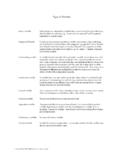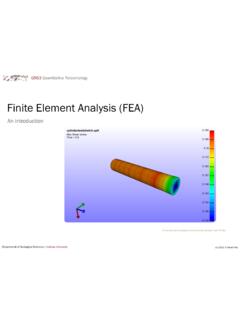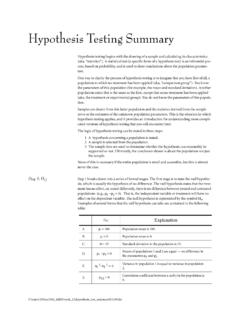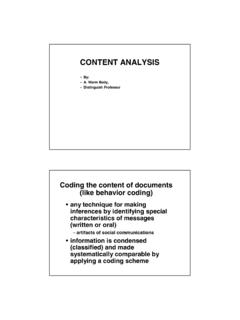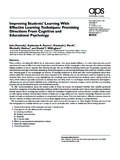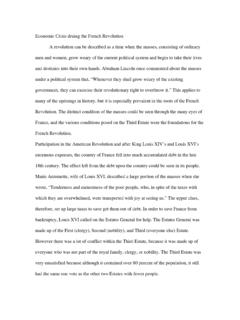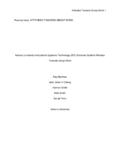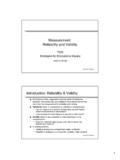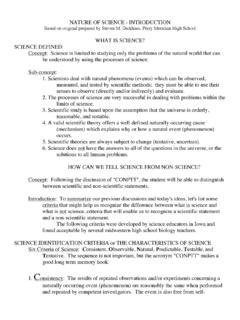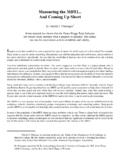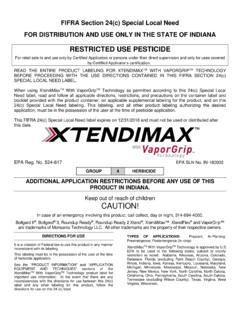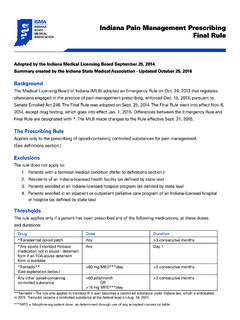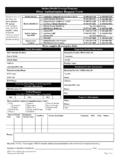Transcription of Measurement
1 1 Measurement -1 MeasurementY520 Strategies for Educational InquiryRobert S MichaelMeasurement-2 How are variables measured? First, variables are defined by conceptual definitions(constructs) that explain the concept the variable isattempting to capture. Second, variables are defined by operationaldefinitions; that is, definitions of how variables will : Study effort (a) The variable study effort may be definedconceptually as the amount of effort required to mastera body of material, including reading, looking updefinitions, note-taking, drill, self-quizzing, and soforth. Each of these components must be operationalized inorder to be : Study effort (b) The variable study effort may be said to consist ofreading, looking up definitions, note-taking, drill, andself-quizzing.
2 Reading (operational definition): How many hoursper day do you read course related material? Looking up definitions (operational definition): Onaverage, how many words per textbook page doyou look up?3 Measurement -5 Example: Study effort (c) The variable study effort may be said to consist ofreading, looking up definitions, note-taking, drill, andself-quizzing. Note-taking (operational definition): How manypages of notes do you take per textbook page? Doyou consolidate your notes by taking notes on youroriginal notes? Drill (operational definition): How many hours perday do you drill on new terms and formulas? Measurement -6 Operational definitions - Constructs In any research project it is important to involve keyplayers in the formulation of operational definitionsbecause: Operational definitions should be consistent withconstructs.
3 Critiques of poorly constructed operationaldefinitions can be used for improvement. Constructs are often inferred from is Measurement ? Measurement is the assignment of numerals to objectsor events according to rules. Numeralsare labels that have no inherentmeaning, for example zip codes, or automobilelicense plates. Numbersare numerals that have quantitativemeaning and can be analyzed, for example, is Measurement ? The rules for assigning labels to properties ofvariables are the most important componentsof Measurement , because the result of poorrules is meaningless outcomes. Concepts often cannot be measured directly, , intelligence, so what is usuallymeasured are indicators of constructs, such asspeed, logic, verbal skill, of Measurement Four levels of Measurement have been levels differ in how closely they approach thestructure of the number system we use.
4 Understanding the level of Measurement of variablesused in research is important because the level ofmeasurement determines the types of statisticalanalyses that can be conducted. The conclusions that can be drawn from researchdepend on the statistical analysis of Measurement : Nominal Nominal level Measurement uses symbols to classifyobservations into mutually exclusive and exhaustivecategories. Mutually exclusive means the categories must bedistinct so that no observation falls into more thanone category. Exhaustive means sufficient categories must existso that all observations fall into some of Measurement : Nominal This is the most basic level of Measurement . At this level we can determine only whethertwo observations are alike or different.
5 Example: In a survey of teachers, sex wasdetermined by a question. Observations weresorted into two mutually exclusive andexhaustive categories, male and could be labeled with the lettersM and F, or the numerals 0 and of Measurement : Nominal In the same survey the variable of martialstatus could be measured by two categories,married and unmarried. But, these categories must each be defined sothat all possible observations will fit into onecategory but no more than one: legallymarried, common-law marriage, religiousmarriage, civil marriage, living together, nevermarried, divorced, informally separated, legallyseparated, widowed, annulled, abandoned, etc7 Measurement -13 Levels of Measurement : Nominal In nominal Measurement , all observations inone category are alike on some property anddiffer from the members in the other categoryon that property ( , sex, martial status).
6 On ordering of categories exists. We cannotsay one category is better or worse, or more orless than of Measurement :Nominal Numbers used as Names Basic Empirical Operations Determination of equality Permissible Statistics Number of cases Mode Contingency correlation Examples Numbers on basketball jerseys Assignment of type or model numbers to classes8 Measurement -15 Levels of Measurement : Ordinal Ordinal level of Measurement uses symbols toclassify observations into categories that are not onlymutually exclusive and exhaustive. In addition, thecategories have some explicit relationship amongthem. Observations may be classified into categories suchas taller and shorter, greater and lesser, faster andslower, harder and easier, and so forth.
7 The categories must be exhaustive and of Measurement : Ordinal Most questionnaires use Likert type example, we may ask teachers abouttheir job satisfaction. Asking whether a teachers is very satisfied,satisfied, neutral, dissatisfied, or verydissatisfied is using an ordinal scale of Measurement :Ordinal Rank order data Basic Empirical Operations Determination of greater or less Permissible Statistics Median Percentiles Rank order correlation Examples Scores on cognitive & affective measures Hardness of minerals Quality of performance; objects (wool, meals, etc) Measurement -18 Level of Measurement : Interval The interval level of Measurement classifiesobservations into mutually exclusive andexhaustive categories that have some explicitrelationship among them, and the relationshipbetween the categories is known and is the first quantitative application of Measurement : Interval In the interval level of Measurement , acommon and constant unit of Measurement isestablished between the categories.
8 Forexample, measures of temperature areinterval scales. A temperature of 75 is one degree coolerthan a temperature of 76 ; likewise, atemperature of 32 is one degree warmerthan a temperature of 31 . Measurement -20 Level of Measurement : Interval Numbers may be assigned to observationsbecause the relationship between any twocategories is assumed to be the same as therelationship between numbers in the numbersystem. For example, 76-1=75 and 31+1=32. Intervals between categories are equal butthey originate from some arbitrary point oforigin. No meaningful zero point of Measurement :Interval Equal intervals Basic Empirical Operations Determination of equality of intervals / differences Permissible Statistics Mean Standard deviation Product-moment correlation Examples Standard scores on cognitive & affective scales Temperature: Fahrenheit & centigrade scales Calendar datesMeasurement-22 Levels of Measurement : Ratio The ratio level is the same as the intervallevel with the addition of a meaningful andnon-arbitrary zero point.
9 Examples: Weight, area, speed, velocity. Ineducation, budgets and number of studentsare measured on ratio of Measurement : Ratio Variables measured at a higher level canalways be converted to a lower level but notvice versa. Observations of actual age (ratio scale) canbe collapsed to categories of younger andolder (ordinal scale), but age measuredsimply as younger or older cannot beconverted to measures of actual of Measurement :Ratio Equal intervals & Absolute zero Basic Empirical Operations Determination of equality of ratios Permissible Statistics Same as for interval Coefficient of variation Logarithmic transformations Examples Temperature: Kelvin scale Length, weight, force, etc. Money13 Measurement -25 Levels of Measurement :Review What level of Measurement is each of thefollowing, and what is your reasoning?
10 Numbers in street addresses. Order of finish in 100 yard dash. Social Security Numbers. Number correct on classroom spelling quiz. Number correct on in Measurement The following slide contains a list of nineitems. For each item: Describe how we measure, Identify the level of Measurement , Describe the inference we make, and Describe the in of of of chill Index (Smog Index / Pollen Index) Constructs How would you describe the relationship(s) amongthe following: Operational definitions Variables Measurement Scales of Measurement Inferences from measurements Constructs Discuss each for the items on the following slide15 Measurement -29 Inventing :Intelligence and its Measurement Intelligence is one construct that continues togenerate discussion, and divergent opinions.
